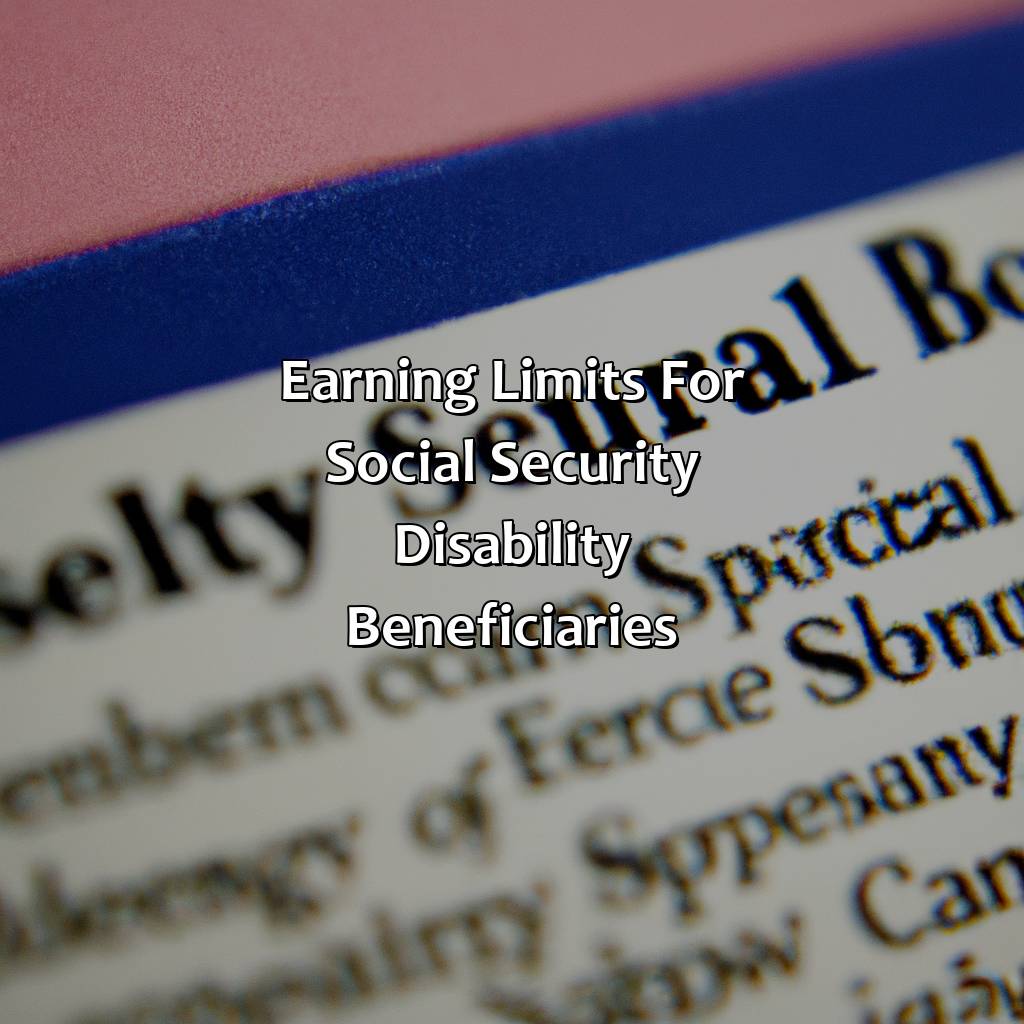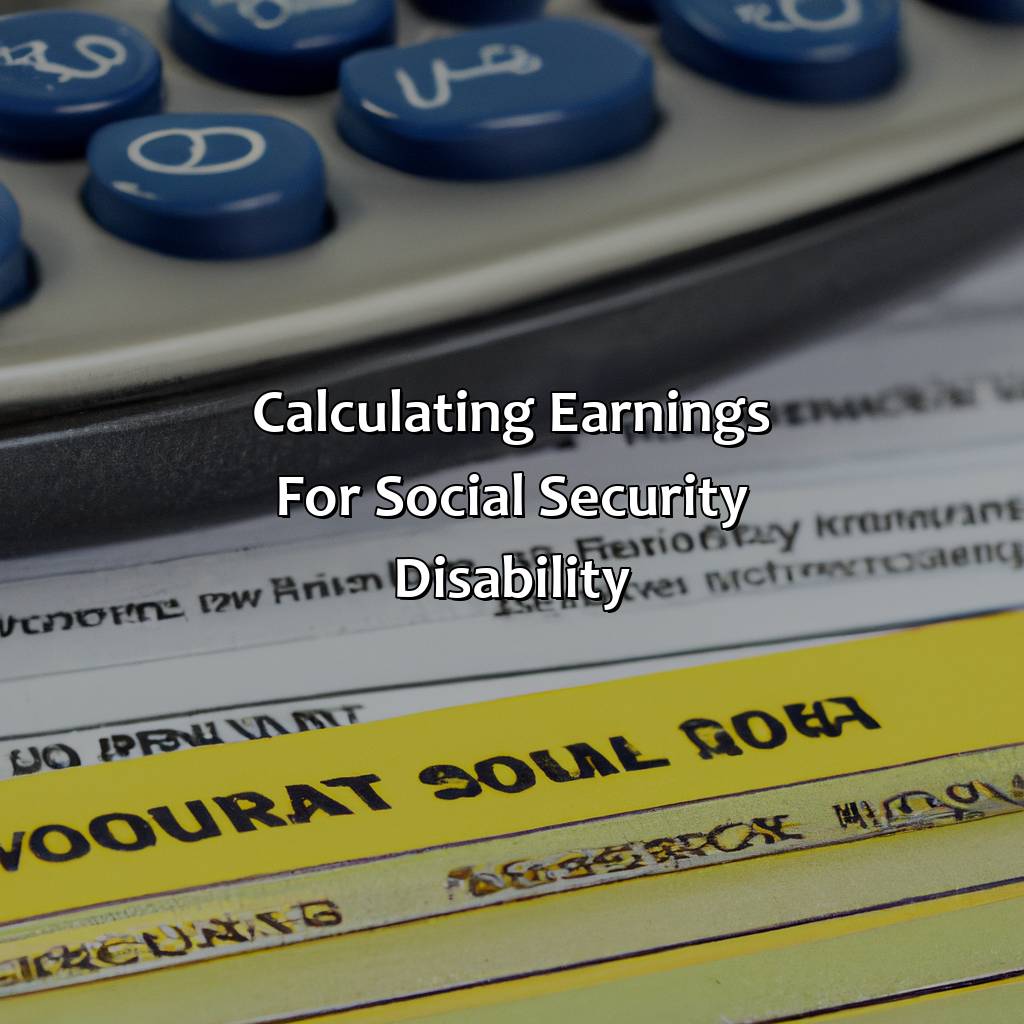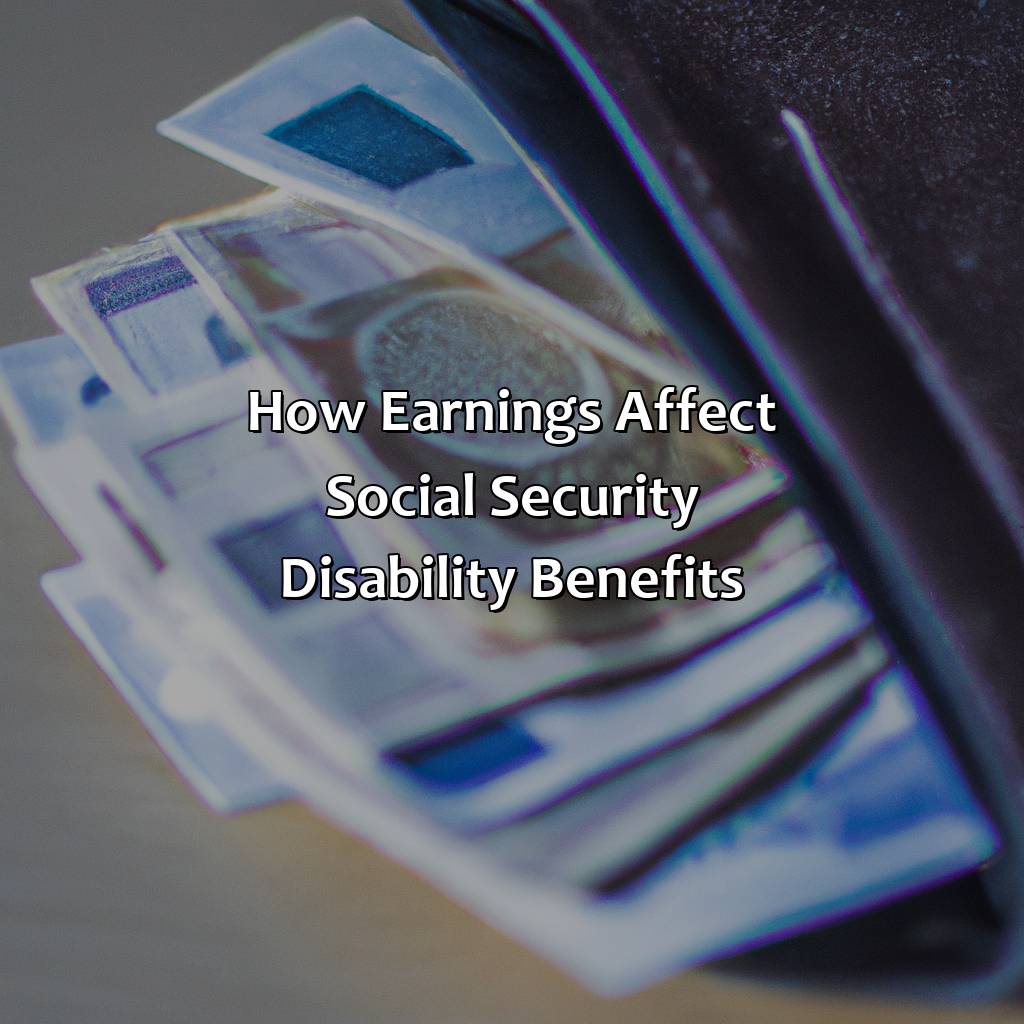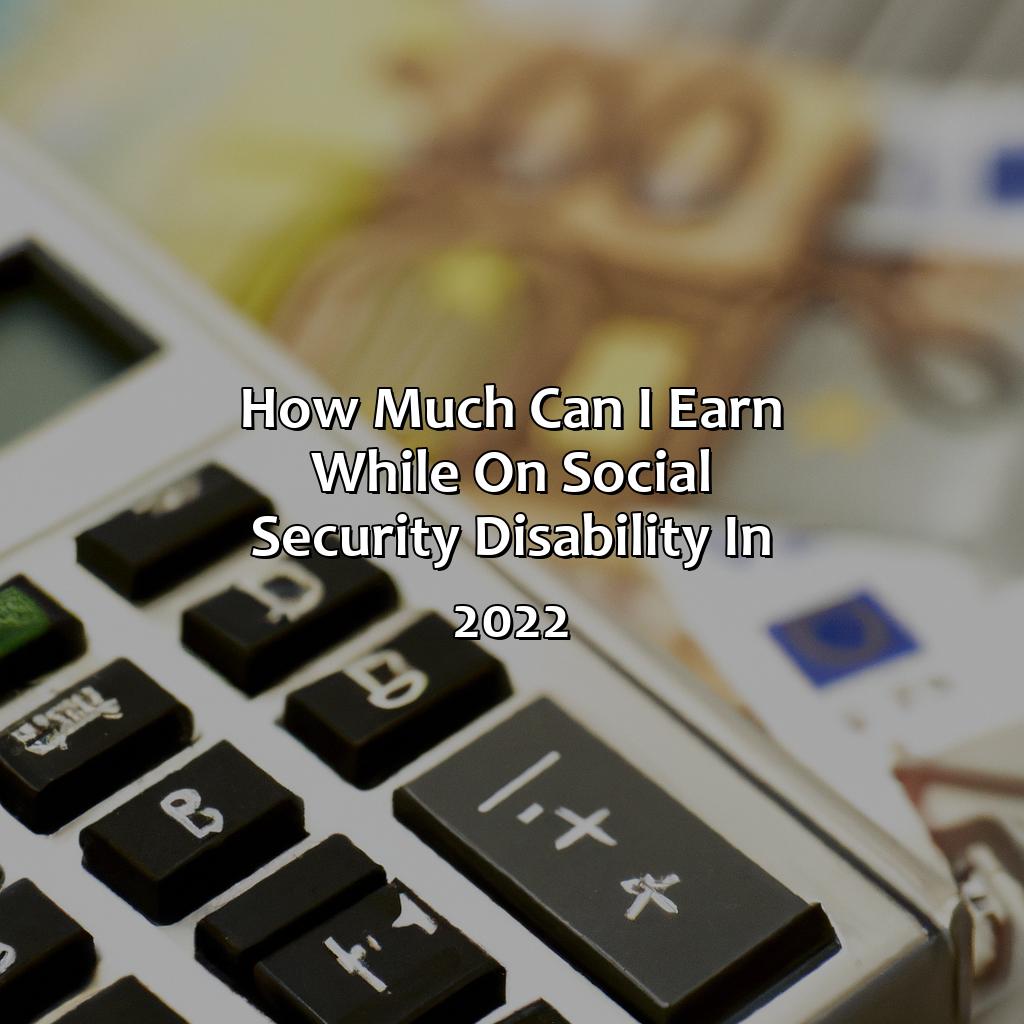How Much Can I Earn While On Social Security Disability In 2022?
Key Takeaway:
- Social Security Disability beneficiaries have earning limits that determine how much they can earn without affecting their benefits. The monthly income limit for 2022 is $1,310 for non-blind individuals and $2,190 for blind individuals.
- During the Trial Work Period, beneficiaries can earn any amount for nine months without affecting their benefits. After that, Substantial Gainful Activity limits apply, where beneficiaries cannot earn more than $1,310 per month. However, beneficiaries can deduct Impairment-Related Work Expenses from their earnings to reduce their income.
- Earnings affect Social Security Disability benefits by reducing or terminating benefits based on the amount of income earned. However, there are exceptions, such as the Student Earned Income Exclusion and Blind Beneficiaries, that allow individuals to earn more without affecting their benefits.
Are you worried about how you’ll make ends meet while on Social Security Disability in 2022? You’re not alone. Discover how much you can earn and the rules to follow so you can maximize your income.
Overview of Social Security Disability
The Basics of Social Security Disability
Social Security Disability is a federal program that provides financial support for disabled individuals who cannot engage in substantial gainful activity due to a medical condition. The program is designed to help people who are unable to work due to a disability, and it provides monthly payments to eligible individuals.
To qualify for Social Security Disability, applicants must meet specific criteria set by the Social Security Administration. These criteria include having a medical condition that meets the SSA’s definition of disability and having worked and paid Social Security taxes for a certain period.
Once approved for Social Security Disability, beneficiaries are entitled to receive monthly payments that are based on their earnings history. These payments are adjusted annually to keep pace with inflation and other economic factors.
In addition to monthly payments, Social Security Disability beneficiaries may also qualify for other benefits, such as Medicare and Medicaid.
Overall, the Social Security Disability program provides critical support for disabled individuals and their families. It is a vital safety net that helps ensure that those who cannot work due to a disability are still able to pay their bills and enjoy a basic standard of living.

Image credits: retiregenz.com by Joel Washington
Earning Limits for Social Security Disability Beneficiaries
To grasp the earning limits for social security disability beneficiaries, explore the section ‘Earning Limits for Social Security Disability Beneficiaries‘. This section holds three sub-sections:
- Monthly Income Limit
- Trial Work Period
- Substantial Gainful Activity
These sub-sections provide insight into the monthly earning limits and trial work period. They also help those with disabilities comprehend the earning limits they must remember when using benefits.

Image credits: retiregenz.com by Joel Arnold
Monthly Income Limit
Income Limits for Social Security Disability Beneficiaries
If you are receiving Social Security Disability Benefits, you must adhere to the monthly income limit to continue receiving benefits. As per the SSA guidelines, for 2022, the income limit is set at $1,310 for non-blind beneficiaries and $2,190 for blind beneficiaries.
To calculate if you have surpassed this earning limit, SSA considers your gross earnings minus any allowable deductions such as Impairment Related Work Expenses (IRWEs) and some other work expenses. Your net earnings after such deductions should not go above the monthly income limit to continue receiving benefits.
It is crucial to report your earnings accurately to avoid any overpayment issue or legal action by SSA. Additionally, it’s always wise to take professional guidance from experts specializing in SSDI laws before engaging in work that may impact your benefits.
Pro Tip: Keep yourself abreast of ongoing changes in income limits and report your earnings accurately to ensure smooth benefit payments. You can try working, but don’t get too attached, it’s called a ‘trial’ for a reason.
Trial Work Period
During the introductory period of Social Security Disability, the authorities may allow the beneficiary to engage in work, known as a ‘try-out’ period under current laws. This period is called the ‘Testing Period.’
The Testing period commences when beneficiaries earn more than 940 dollars per month (for 2022), and it continues for nine months. During this time, applicants receive their full benefits regardless of their earnings.
After completion of this trial period, individuals must either lower their monthly earnings to acceptable objective thresholds or forfeit receiving SSDI benefits. The below-substantial gainful activity (SGA) earning threshold amount is $1310 in 2022.
To ensure an effortless transition to a career alongside SSDI benefits, individuals should speak with local employment networks offering resources for job-seeking people with disabilities.
Don’t miss out on your best opportunity if you’re eligible for disability social security benefits by not knowing how much you can make. Remember that exceeding the SGA limit can result in revocation of your SSDI benefits.
Looks like ‘substantial gainful activity‘ is just a fancy way of saying ‘you better not make too much money or we’ll cut your benefits‘.
Substantial Gainful Activity
To be considered eligible for Social Security Disability benefits, a person must not be engaged in what is known as “Substantial Gainful Activity,” or SGA. This refers to any work activity that brings in a significant amount of money each month. In 2022, the monthly SGA limit is $1,310 for non-blind individuals and $2,190 for those who are considered blind.
If an individual on Social Security Disability exceeds the SGA limit threshold, then their monthly payments may be reduced or terminated altogether. However, it is important to note that there are several exemptions and exceptions to the SGA rule. For example, undergoing vocational rehabilitation would typically not count towards the SGA limit. Similarly, certain types of self-employment income may also be excluded from the calculation.
It is essential to keep track of your monthly earnings and report them accurately to Social Security Disability administrators regularly. If you exceed the SGA limit unintentionally due to temporary income spikes but can demonstrate that you have made efforts towards re-joining the workforce without relying on disability payments before approaching this threshold value, it is possible for you to receive benefits initially.
One suggestion for staying below the SGA threshold is working part-time or keeping track of total hours worked despite how much gets earned each month carefully. Another suggestion involves taking advantage of trial work periods wherein people with disabilities can test their ability to earn above SGA levels without worrying about benefit terminations initially. It’s an excellent way for disabled individuals seeking employment while continuing receiving medical care related benefits but make sure you plan accordingly before striking out on these steps based on your current health status and Disability stipulations recognized by your region’s office of Social Security Administrations.
Who knew math could be so depressing? Calculating earnings for Social Security Disability just takes the joy out of numbers.
Calculating Earnings for Social Security Disability
Figuring out how much you can earn while receiving Social Security Disability is not so simple. Gross Income is the amount made before taxes and deductions. Impairment-Related Work Expenses are the costs of special gear or services needed to perform your job. This part helps to understand precisely how much can be earned while getting Social Security Disability benefits.

Image credits: retiregenz.com by Yuval Duncun
Gross Income
Income received before taxes and other deductions are subtracted is known as total earnings, which are also referred to as gross income. Gross income is used to calculate Social Security Disability benefits among other things. It includes wages, commissions, tips, bonuses, and self-employment income.
Calculating gross income for Social Security Disability (SSD) purposes involves considering all forms of earned income. There is no cap on the amount an individual can earn while receiving SSD benefits. However, SSD beneficiaries must report their earnings to the SSA each year. The Social Security Administration deducts an amount from your monthly benefits if your earnings exceed a certain limit.
To calculate the number of months that count against the Trial Work Period (TWP), the Social Security Administration uses gross income in detecting one’s eligibility for disability benefits while working or earning money with a disability. Their benefit payments resume at full pace once they complete nine Trial Work Periods within seven years.
It is recommended for beneficiaries with high incomes to work on choosing work opportunities that help adjust their income levels below SSA thresholds when returning to work full-time. This will help ensure that payments stay intact by following these calculations of significant earnings from employment yearly or twice a month reports during this time period.
Who knew being disabled could be so expensive? Impairment-related work expenses will have you wishing you were just able-bodied and broke.
Impairment-Related Work Expenses
Expenses Incurred due to Work-Related Limitations
If you have work limitations due to your impairments, certain expenses incurred in relation to work can be deducted. These expenses are known as Impairment-Related Work Expenses and include items such as specialized equipment, attendant care services, and job coaching.
These deductions reduce your countable earnings for Social Security Disability Income (SSDI). You must keep a record of all these expenses and submit them to the Social Security Administration (SSA) on demand.
It should be noted that these expenses are only deductible if they result from your impairment and are necessary for you to continue working.
In 2022, the threshold for SSDI income limits is $1,310 per month for non-blind individuals and $2,190 per month for blind individuals. Anything earned above this limit will impact your eligibility for SSDI payments.
A friend of mine who had a spinal cord injury needed a specialized wheelchair to perform his job duties. The cost of the wheelchair was deductible under Impairment-Related Work Expenses and helped him continue working despite his impairments. Keeping precise records allowed him to deduct the amount from his countable income and remain eligible for SSDI payments.
Looks like getting a job and earning money could potentially leave you with less disability benefits than your ex’s lawyer.
How Earnings Affect Social Security Disability Benefits
If you want to know how money you earn can change your social security disability benefits, check out the section “How Earnings Affect Social Security Disability Benefits.” This is in the article: “How Much Can I Earn While on Social Security Disability in 2022?” There are two subsections that offer solutions:
- “Reduction of Benefits”
- “Termination of Benefits.”

Image credits: retiregenz.com by Yuval Washington
Reduction of Benefits
Social Security Disability Benefits can be reduced if an individual’s earnings exceed a certain limit. This reduction is based on the amount of income earned and can result in a decrease in monthly benefits.
The reduction of benefits is determined by the Social Security Administration and depends on a number of factors. These factors include the type of disability benefit received, the recipient’s age, and their various sources of income. Therefore, it is important for individuals to regularly educate themselves about any changes in these regulations so that they can plan accordingly.
It should also be noted that special rules apply for individuals who are considered legally blind, which can help retain higher levels of benefits despite increased earnings.
To avoid unnecessary reductions in benefits due to excess earnings, individuals receiving Social Security Disability Benefits should carefully monitor and report all sources of income to the Social Security Administration. It may also be helpful to seek professional advice from financial advisors or legal professionals who specialize in this area.
By staying informed about regulations related to Social Security Disability Benefits and developing effective strategies for managing earnings, individuals can maximize their benefits while still earning an income.
Getting kicked off disability benefits is like getting slapped with a reality check, but without the satisfying sting.
Termination of Benefits
Once a beneficiary starts earning above the substantial gainful activity (SGA) threshold, their Social Security Disability Insurance (SSDI) or Supplemental Security Income (SSI) benefits may be terminated. This can occur when a person’s income exceeds the SGA limit of $1,370 per month for non-blind individuals and $2,290 per month for blind individuals in 2022.
Additionally, if an individual is eligible for a trial work period (TWP), they have nine months within any 60-month rolling period to earn as much as they can without affecting their benefits. However, once this trial period is over and they continue earning more than the SGA limit, their benefits will stop.
It’s important to note that only earned income counts towards the SGA limit. Unearned income such as investment income or rental payments do not affect benefits. If an individual is unsure about how much they can earn while receiving benefits, it’s best to consult with a Social Security representative.
According to the Social Security Administration website, “Social Security disability beneficiaries are encouraged to return to work when they are able.” The agency provides many resources and support programs such as vocational rehabilitation services that help individuals with disabilities return to work if possible.
Breaking the earning limits for Social Security Disability? Might as well break out the disco ball and get the party started.
Exceptions to Earning Limits for Social Security Disability
To get around earning limits with Social Security Disability benefits, explore exceptions. In this section, it covers Exceptions to Earning Limits for Social Security Disability. There are two sub-sections:
- Blind Beneficiaries
- Student Earned Income Exclusion
Learn about them here!

Image credits: retiregenz.com by David Washington
Blind Beneficiaries
Individuals with a severe visual impairment can qualify for Social Security disability benefits. These beneficiaries are considered visually impaired or blind and may be eligible for unique earning limits and work incentives provided by the Social Security Administration.
For Blind Beneficiaries, the earnings limit is usually higher than that of non-blind beneficiaries. In 2022, individuals who are legally blind per SSA’s definition can earn up to $2,190 per month without affecting their disability benefits. This adjusted monthly limit applies to both Supplemental Security Income and Social Security Disability Insurance.
Furthermore, blind beneficiaries may also participate in several work incentive programs to gradually return to the workforce without losing their benefits. They can use expedited re-entitlement to adjust for any decrease due to earnings and later increase back up if they are unable to continue working.
In 1978, Congress enacted legislation allowing special provisions related to earnings and work incentives for disabled workers who are legally blind as part of the Social Security Act. Since then, these provisions have provided necessary support to enable visually impaired persons towards self-sufficiency while receiving disability benefits.
“I may be a student, but my income exclusion game is strong – Social Security Disability, you can’t hold me back!”
Student Earned Income Exclusion
Individuals who receive social security disability benefits may be eligible for certain exclusions to earning limits, one of which is the “educational exemption.” This allows SSDI beneficiaries who are students to continue receiving some form of financial aid despite earning income through employment.
The Student Earned Income Exclusion, as it is commonly known, allows students with disabilities to exclude up to $7,050 from their annual earnings when reporting income to the Social Security Administration. This exclusion only applies to individuals who receive SSDI and are under the age of 22 or enrolled in an educational institution on a full-time basis.
It’s important to note that this exclusion only applies if the individual is using the money earned towards education-related expenses, such as tuition fees or textbooks. Any income earned above this amount may reduce the recipient’s monthly SSDI payment.
If you’re a student with a disability and receiving SSDI benefits, make sure you take advantage of the Student Earned Income Exclusion. By doing so, you can continue your education without fear of losing financial aid while also earning a living.
Don’t miss out on this opportunity- contact your local Social Security office for more information on how you can use the Student Earned Income Exclusion today.
Five Facts About How Much Can I Earn While on Social Security Disability in 2022:
- ✅ The maximum Social Security disability benefit for 2022 is $3,011 per month. (Source: Social Security Administration)
- ✅ To qualify for Social Security disability benefits, you must have worked long enough to earn sufficient work credits. (Source: AARP)
- ✅ Social Security disability benefits are not means-tested, so your income and assets do not affect your eligibility. (Source: Nolo)
- ✅ You can earn up to $1,310 per month in 2022 and still qualify for Social Security disability benefits. (Source: Social Security Administration)
- ✅ If you earn more than the substantial gainful activity (SGA) limit of $1,310 per month, your Social Security disability benefits may be reduced or eliminated. (Source: Disability Benefits Help)
FAQs about How Much Can I Earn While On Social Security Disability In 2022?
What is the maximum amount you can earn while on Social Security Disability in 2022?
The maximum amount you can earn while on Social Security Disability in 2022 is $1,310 per month.
Does the maximum earning limit change every year?
Yes, the maximum earning limit for Social Security Disability benefits changes every year. For 2022, the maximum earning limit is $1,310 per month.
If I earn more than the maximum limit, will I lose my Social Security Disability benefits?
If you earn more than the maximum limit, your Social Security Disability benefits may be reduced or suspended. You should report any earnings to the Social Security Administration to avoid any penalties or overpayments.
Are there any types of earnings that do not count towards the maximum limit?
Yes, there are some types of earnings that do not count towards the maximum limit, such as income from rental property, investments, or spouse’s income. However, you should report all income to the Social Security Administration to ensure accurate benefit calculations.
Can I work while I am waiting for a decision on my Social Security Disability claim?
Yes, you can work while you are waiting for a decision on your Social Security Disability claim. However, you should still report any earnings to the Social Security Administration to avoid any issues with your benefits.
Is there a limit to how much I can earn if I am receiving both Social Security Disability and Supplemental Security Income?
Yes, if you are receiving both Social Security Disability and Supplemental Security Income, the maximum earning limit is $1,310 per month in 2022.
